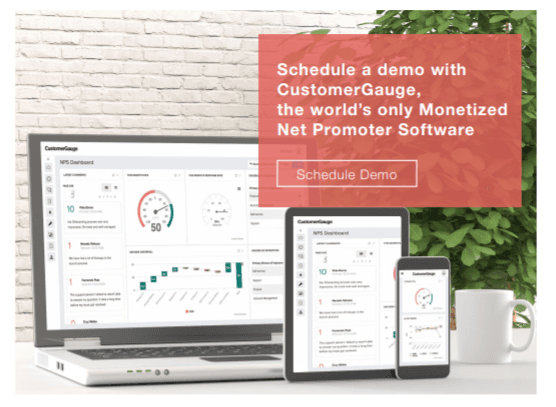Introduction
As customer expectations are rapidly increasing, business leaders are realizing that to stay ahead of the competition, they need to become better at reacting to customers’ feedback and needs. A recent study by Forrester revealed that companies are already rethinking their business strategies in order to become more customer-centric, with 72% saying that improving customer experience (CX) is a top priority.
The implications are clear: companies can no longer afford to be CX laggards according to a study from NewVoiceMedia, which states that companies lose more than $62 billion due to poor customer service. So, how can companies around the world ensure they adopt best practices when addressing customer feedback, retention and growth strategies to stay competitive?
First and foremost, pay close attention to what’s working for business leaders in your industry. Top business performing companies aren’t leaving their CX up to chance, they’re using a proven metric and system: the Net Promoter System® (NPS).
Using data gathered from CustomerGauge.com/Benchmarks and CustomerGauge, in this eBook we’ll discuss how some of the top Fortune 500 companies use the Net Promoter System to learn from customer feedback, retain customers better and grow their business. The information in these pages includes:
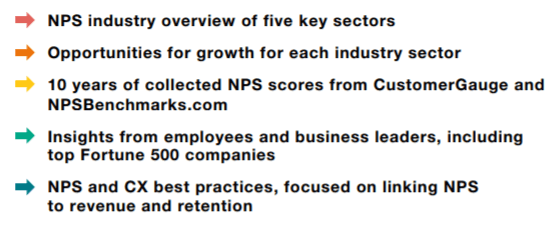
Technology Industry Oveview
Cutting-edge technology companies are always on the look for unconventional and innovative ways to meet the CX demands of their tech-savvy consumers. Tech leaders who are continuously meeting and exceeding customer expectations are not only enjoying higher profits, but also a strong customer base of promoters. Here’s what you need to know about the technology industry’s NPS performance and upcoming trends.
NPS Industry Highlights
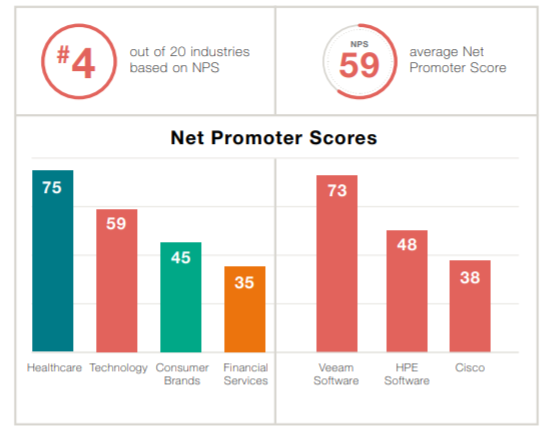
Upcoming Opportunities for Growth
According to Deloitte’s Technology Industry Outlook 2017, there are numerous upcoming opportunities for growth for companies that will be both customer and innovation-focused. The Internet of Things, artificial intelligence (AI), 3-D printing,blockchain and cybersecurity products and services are among the top opportunities for growth to be on the lookout for. PwC research further confirms that AI is having a massive impacton CX, especially in the technology industry. Here are some statistics to keep in mind:

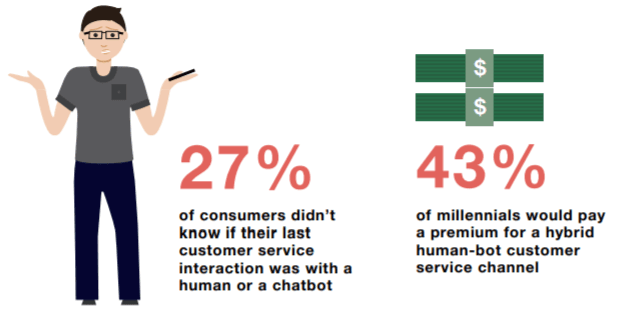
Veeam Software
Veeam Software is an innovative provider of solutions that deliver Availability for the Always-On Enterprise™. The tech company develops backup, disaster recovery and virtualization management software for VMware and Hyper-V virtual environments. Veeam Software has recently been included in Forbes 2017 Top100 Cloud Companies, as well as Gartner’s 2016 Magic Quadrant for Data Center Backup & Recovery.
Veeam Software has been investing in NPS for years, and the results show the company’s score is increasing on a yearly basis. Here’s what you need to know:

In 2015, Veeam Software introduced gamification to their customer support team
in order to increase customer satisfaction. The gamification system showed a weekly leaderboard, individual achievements, and a closed-case progress bar. The system then tracked each team member’s activities and assigned reward points for completed tasks. For Veeam, the use of gamification has helped managers improve performance by pinpointing problematic issues or bottlenecks in the work process, in turn creating an experience that creates loyal, happy customers. The result? Their NPS improved by 32 points to 62 for 2015.

Veeam Software’s NPS improvements have also been accompanied by phenomenal financial gains. Not only did Veeam see NPS improve by 11 points in 2017, but it also achieved a 27% year-over-year increase in revenue growth. The company is also very proactive in drilling down the reasons why customers are satisfied and willing to recommend the company. Based on their analysis, Veeam have discovered that customers highlight the quality of products and the professional work of the customer support department as top reasons why they recommend the brand. As a result, the company has become better equipped to make strategic business decisions that make a difference to the bottom line.
Customer Satisfaction KPIs
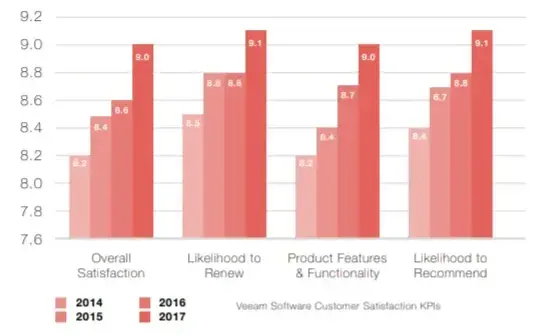
Financial Services Industry Overview
Improving CX in the banking and financial services industry has never been more important. With customers becoming increasingly tech-savvy and expecting a more personalized banking experiences, banks simply cannot afford to operate in the traditional inside-out CX approach. The good news is that a recent FSI Adobe Summit uncovered that the financial services industry is rapidly catching up in terms of customer focus. 63 percent of 840 FSI executives have marked customer experience as their top priority for 2017 — a 17 percent increase over 2016. Still, compared to other industries like consumer brands and technology, the financial services average NPS still has room for improvement. Here’s what you need to know about the financial services industry’s Net Promoter Score performance and upcoming trends.
NPS Industry Highlights
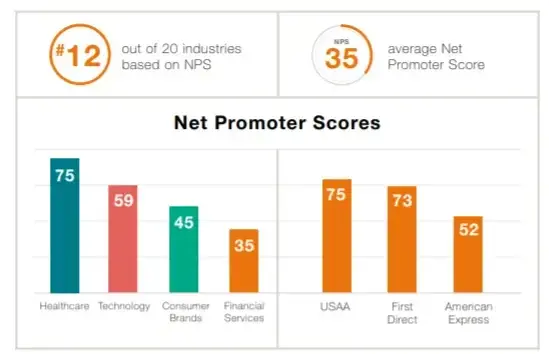
Upcoming Opportunities for Growth
According to a PwC survey, in order to be successful, banks need to sell to buyers where they are, offer products that customers find personally relevant, and reach customers when and where they’re receptive. In addition, 46% of consumers now interact via digital form only, skipping physical channels altogether, a huge jump from the 27% share seen in 2012. In-person branches should not become obsolete though—people prefer omni-digital.
You can read more about some of the key upcoming CX & NPS trends in the financial services industry here.
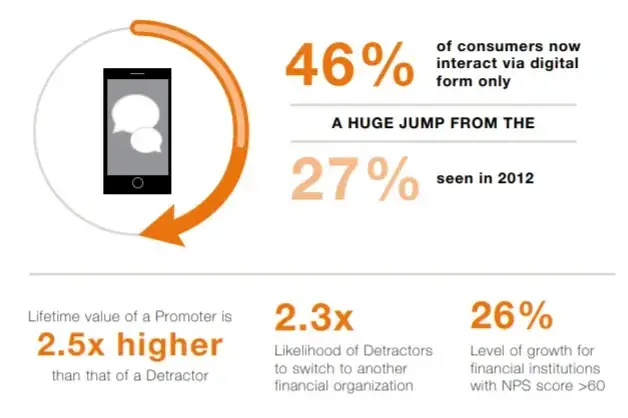
USAA
The United Services Automobile Association (USAA) is a Texas-based Fortune 500 diversified financial services group of companies and subsidiaries offering banking, investing, and insurance. USAA has a substantial track record of CX & NPS top rankings. The company was recently placed as a CX winner in KPMG Nunwood’s 2017 Customer Experience Excellence Analysis for the financial services sector. USAA has also been ranked the highest among US financial services firms, according to Forrester’s 2016 Customer Experience Index (CX Index™). To top it off the Fortune 500 giant has been named Top-Ranked Company in Net Promoter Index of Customer Loyalty from 2009 to 2016.
USAA’s NPS score for Banking is 75. When we compare this score to the industry’s
average of 34, we can see that the company excels in customer loyalty and
satisfaction. So how does USAA do so well? The answer is simple: they put client
needs before profits, invest in client engagement technologies and create effortless
client experiences.


Customers Before Profits
USAA is committed to putting customers’ needs before profits. In doing so, the company is carefully monitoring customer feedback to better understand drivers of satisfaction and dissatisfaction. USAA has found that some of their key drivers for customer loyalty and satisfaction include the ease of doing business with the company and the feeling that customers are treated fairly. As a result, the company has invested its business initiatives in building high customer trust and effortless customer experiences.
Your experiences and feedback drive “our innovation”
In order to build robust customer trust, USAA customers are regularly brought into the company’s offices to speak with employees at all levels about their challenges.
In the end, USAA measures success by how well their customers are doing financially, not the company itself.
In 2016, the company’s more than 29,000 employees helped USAA achieve a
whooping customer retention rate of 98%, proving that building an effortless customer
experience correlates with business growth.
Client engagement technologies and effortless experience
USAA’s product and service innovation are driven by customers’ needs and with the purpose of making their lives easier. The company was the first bank to allow customers to check their bank balances via text messages and email. Today this might be a common practice, but back in 2009 it helped USAA establish itself as truly customer-centric company. USAA has even managed to provide a truly free checking account by finding a way to profitably reimburse up to $15 a month in ATM fees charged by other banks.
Travel, Leisure & Hospitality Overview
For executives in the travel, leisure and hospitality industries, the creation of truly customer-centric strategies will become crucial to their success in the upcoming years. While developing their innovative and CX offerings, the travel, leisure and hospitality industry needs to also pay close attention to economic trends. Deloitte highlights that hotels, airlines, and other travel segments are particularly vulnerable to the ebbs and flows of economic conditions as they directly affect consumers. Here’s what companies from the sector need to know about the state of NPS in the industry and upcoming trends.
NPS Industry Highlights

Upcoming Opportunities for Growth
Travel, leisure and hospitality companies alike have to meet the challenges of consumer trends, technology and competition. Deloitte’s 2017 Travel and Hospitality Outlook highlights some interesting opportunities for growth for companies in the sector. Here’s what to keep in mind:
- Travel and hospitality companies will remain vulnerable to the risk of external events, such as cyber-attacks and food safety.
- Technologies incl uding AI and th e I n ternet of Things (IoT) will serve to enhance the customer ’s experience and remove pain points from travel.
- IoT sensors will allow travel and hospitality companies to integ rate advanced analytics and machine learning to adapt to customer behavior in real time.
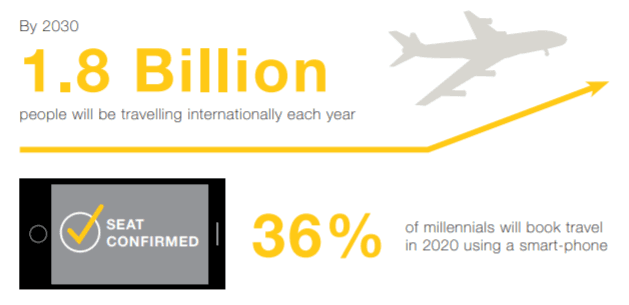
Thomas Cook
Thomas Cook Group plc is one of the world’s leading leisure travel groups with sales of £7.8 billion. The company is famous for its leisure travel services including hotels, flights, deals and cruise. The company has reported a “good performance” in its 2017 third quarter, with revenue rising 14% to £2.27bn. The FTSE 250 travel giant has shared customer satisfaction was also higher, with its NPS up seven points year-on-year in the three months to June 30th.

Because of the company’s high satisfaction, loyalty and growth levels, it stands out as a particularly successful business, begging the question: how do they do it?
NPS is our main customer satisfaction KPI.
Customer care as an engine of growth
Thomas Cook has developed a holistic view of customer care and customer contact. The company has a bold 24 hour satisfaction promise that ensures detractors can go back to promoters within a day. For example, if on arrival a customer’s hotel isn’t as described, the company sorts the issue out within 24 hours. If the issue cannot be resolved, Thomas Cook offers a 25% discount voucher for customers’ next holiday (or a full refund and early flight home). The company is fully aware happy customers are more likely to return and recommend to friends and colleagues.
NPS to manage quality
The importance of NPS as a cornerstone of strategy for performance growth at Thomas Cook cannot be overstated. The company uses NPS as their main customer satisfaction KPI and has found NPS results help Thomas Cook improve CX in a more structured way.
For example, the group has a very diligent and robust method of reviewing which hotels are performing well. The company analyzes the NPS performance of its hotels on a bi-weekly basis, defines action based on complaints received and terminates hotels that are consistent underperformers. As a result of this rigorous monitoring and quality management via NPS, Thomas Cook removed 100 UK hotels over the Winter 16/17. In this way, Thomas Cook ensures customers receive a seamless customer experience in whichever hotel they decide to spend their holiday in.
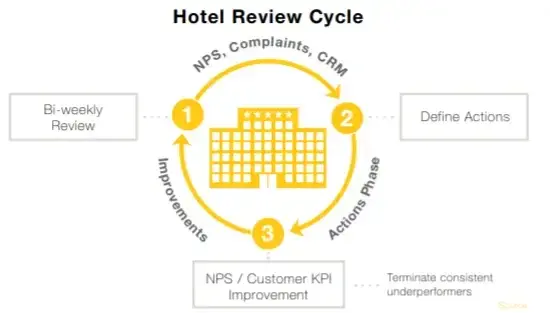
NPS linked to growth in bookings and higher margins
Thomas Cook understands that CX, NPS and revenue go hand in hand. Offering great CX leads to higher NPS and that, in turn, to higher revenue growth. As a result, Thomas Cook has made improving CX a group-wide initiative. Since introducing NPS to the business, Thomas Cook has linked it to management bonuses to insure CX is at the heart of the business operations. The company even uses NPS performance to showcase business health during investor presentations.
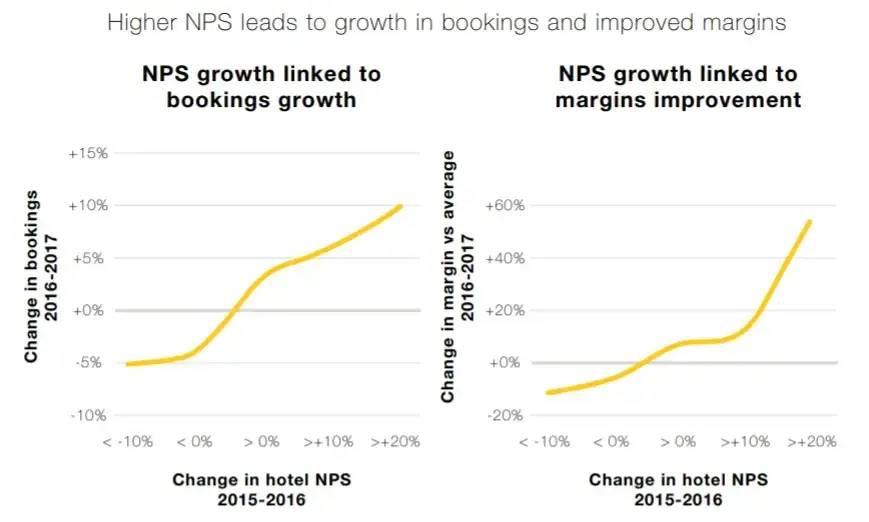
Note: Based on Summer performance of >700 hotels sold by our UK business between 2015 and 2017.Source
Multi-Channel Retail Overview
Having a single channel is no longer enough for meeting the expectations of the “always on” consumers. That is why traditional retailers are on the lookout for establishing an online presence and e-tailers are exploring ways to establish a physical presence. Deloitte shows that a challenge still exists to find a seamless solution for both the customer experience and internal processes. Furthermore, according to SAP, retail companies lose $65 billion in possible revenue through inconsistent customer experience across channels. This requires e-tailers and bricks-and-mortars to rethink their strategies and to redefine their business models. Multi-channel retail leaders such as Amazon, who has recently launched Amazon GO, pose a threat to many retailers with what seems to be one of the most frictionless shopping experiences. Let’s walk through what you need to know about NPS in the multi-channel retail industry.
NPS Industry Highlights
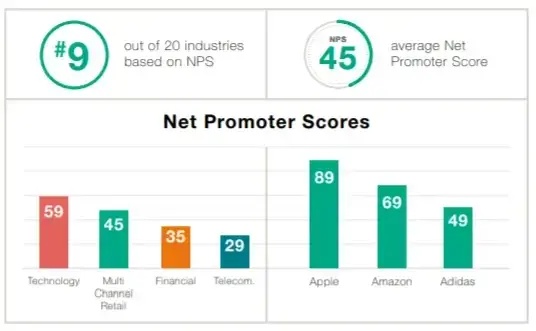
Upcoming Opportunities for Growth
According to PwC, depending on the channel customer expectations and motivations will be different. However, low price wins across all channels. When asked “thinking of your favorite retailer, why do you shop there?", 64% said good prices. In comparison, when asked “What has been your main motivation for buying online", 45% said that it was more convenient. Here are more trends that will shape the future of the multi-channel industry:
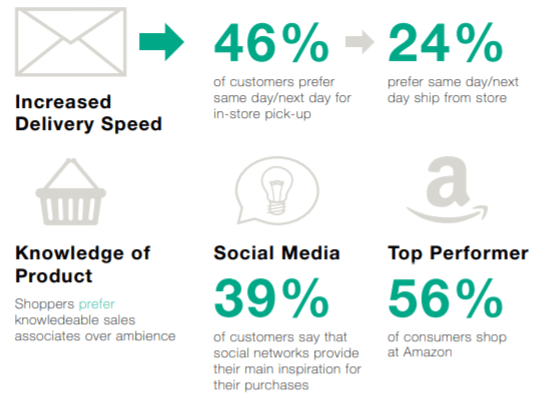
Apple
In 2017, Morgan Stanley conducted a research on the smartphone industry in the USA. The AlphaWise survey has revealed that Apple is far ahead of the competition in terms of customer loyalty. Apple’s iPhone was reported to have 92% retention rate, with the percentage being up from 86% during the same time last year. The multi-channel retail giant is not only enjoying one of the highest retention rates possible, but also a very high Net Promoter Score. Apple tops NPS rankings in a number of important categories, including smartphones, tablets, and laptop computers.
Let’s discover how Apple has increased growth and retention through customer engagement and NPS:
NPS to gauge health of the customer relationship
Apple is one of the biggest advocates of NPS. The company introduced the NPS system back in 2007 and since then has been systematically listening to customers and managing its business in response to their needs. Apple’s feedback surveys include the NPS question, along with an open-ended follow-up question: “Anything else on your mind?”. NPS results help Apple better understand the health of their customer relationship and pinpoint key customer touch points along the customer journey.
Since rolling with NPS, Apple has achieved one of the highest scores in any sector, reaching 89 in 2016. However, the retailer’s high NPS did not happen by pure luck. It was achieved through carefully listening to customer feedback, quickly closing the loop and engaging all Apple employees with NPS.
Engage all employees with NPS
Apple’s centralized NPS team uses customer feedback to better understand the reasons that turn customers into promoters or detractors. Furthermore, Apple’s team does a daily standup, where employees review the NPS feedback received and discuss how to adjust their work accordingly. In this way, the company makes sure its employees understand the importance of paying attention to customer feedback and delighting customers. Finally, Apple makes sure employees know where they stand among their peers in terms of NPS and where their stores stands relative to the rest of the stores in the region. In this way, the company further engages all employees with the NPS program.
Quickly close the loop
Following an NPS survey, Apple store managers call detractors within 24 hours. Research has found that companies that close the loop quickly after receiving customer feedback, experience a 10% increase in retention. This is even more important when it comes to closing the loop with detractors. Apple has found that following up with dissatisfied customers 24 hours after com pleting an NPS survey results in great return on investment. Reichheld highlights that detractors that have been contacted have purchased subsequently more Apple products and services than others.

Telecommunication Overview
The telecommunications industry has historically underperformed in terms of CX. However, according to a 2017 KPMG Nunwood report, there is a handful of telecommunication companies that have made advances in the rankings. The bad news is that the industry is very susceptible to the upcoming disruption from competitors. PwC’s 2017 Telecommunications Trends report warns that companies that offer apps and streaming content directly to consumers through the Internet, have increased their dominance and pose a threat to the telecom sector. In order to survive, players in the sector will need to innovate and personalize their offering. Here’s all you need to know about the state of NPS in the telecommunications sector, as well as trends to be on the lookout for.
NPS Industry Highlights

Upcoming Opportunities for Growth
When it comes to future revenue streams, telecommunication companies need to be able to quickly adapt to the trends that meet the savvy demands of customers. PwC highlights that Over-the-top (OTT) players pose a serious threat to telecommunication CX laggards. OTT companies like WhatsApp, Viber and Apple’s iMessage already represent more than 80% of all messaging traffic, which has lead to many telecom carriers seeing significant drops in customer numbers. As a result, some telecommunication leaders have been quick to modernize their operations and reevaluate their strategy. Here’s what telecom need to be aware of:
- Simplifying data plans instead of cutting costs is a more sustainable path to growth. France’s Free Mobile used this simplification strategy, and boosted its subscriber base by more than 12 million, and now has an 18% share of the French mobile market.
- The rise of 5G networks promises to spark an enormous wave of change starting in 2017.
- The growth of the IoT could dramatically change customer experience, as content can be increasingly delivered to any screen. A lot of these “things” are consumer oriented.
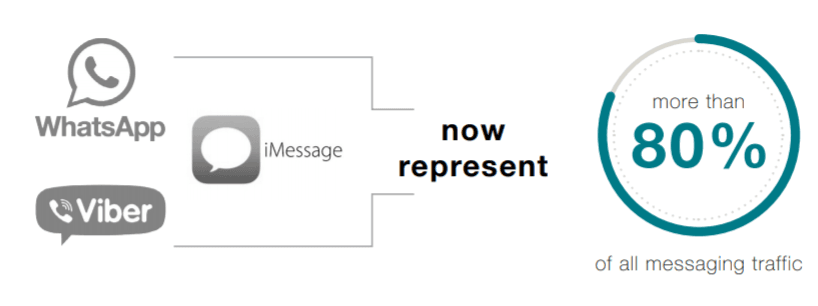
Macquarie Telecom Group
Macquarie Telecom Group is a managed hosting and telecommunications company based in Australia. The company has become a beacon for customer satisfaction in the Australian market and has recently been announced as the leading Australian Net Promoter Score performer. Macquarie’s focus on customer service experience has been a major driving force behind the company’s continued growth and market leading customer loyalty.

Here are some best practice from Macquarie Telecom tips you can implement to beat the competition and achieve high business growth and retention:
Senior buy-in and shorter, real-time surveys
Lack of senior buy-in is one of the key reasons why NPS programs fail to produce fruitful business results. NPS is of ten implemented with no real purpose and with no dedicated team to measure, act, grow and monetize NPS. This was not the case for Macquarie
Telecom Group. While on a flight to San Francisco, DavidTudehope, CEO of Macquarie Telecom, stumbled upon the Harvard Business Review article ‘One number you need to grow’. The read was a real eye-opener. David Tudehope realized that having a long 50 question annual customer survey is not the way forward to better customer experience. Tudehope dumped the traditional customer survey approach in 2012 after discovering that it could be replaced with a simple question for customers: “How likely is it that you would recommend Macquarie Telecom to a friend or colleague?”. Since implementing NPS, the telecommunication company has gone through a trulyfascinating business transformation.
Transparency of NPS shared internally and externally
David Tudehope has become a real evangelist of NPS and true believer of the need for NPS transparency from companies.
People will start asking companies for their NPS score,” he predicts. “It is actually a way of empowering customers.
Tudenhope shares that Macquarie Telecom decided to adopt the whole NPS methodology, “even the parts that were uncomfortable”. After each call, the company collects the NPS data and displays it on screens placed throughout their office in real time. In this way, the company puts an emphasis on the transparency of their NPS - everyone internally and externally can see how well the company is looking after their customers on a real-time basis.
Empowering its employees to go above and beyond for customers is an other factor contributing to Macquarie Telecom NPS transformation journey. The company bases all bonuses on the NPS achievements. Celebrating individuals and teams with high NPS and great customer stories has been a key to Macquarie Telecom’s NPS success. Macquarie Telecom has further driven the way to transparency by displaying their NPS score in real-time on their website.
The results? Macquarie Telecom achieved an NPS of 66 over the Q2 FY17,
which is up almost 50 points from when they started this journey five years ago.
The company has also seen a hand-in-hand correlation between NPS and customer retention and cross-sells.
Conclusion
Keeping track on the state of NPS in your particular industry and learning best practices from the best performers is one of the key ways to increase growth and retention using NPS. Being aware of customers’ needs, as well as upcoming CX trends, will better equip you to make strategic business decisions that lead to sustainable growth.
Throughout this eBook, we covered NPS industry highlights and provided best practices from Fortune 500 companies. We shared our over 10 years of thought leadership and expert advice on what it takes to increase growth and retention with the Net Promoter System.
